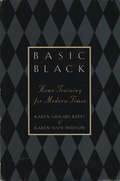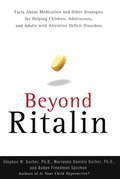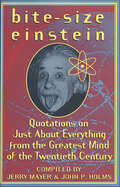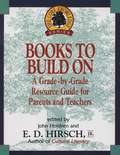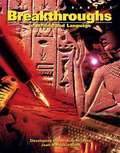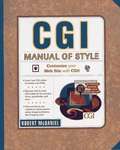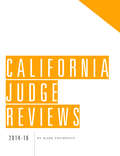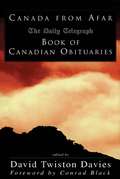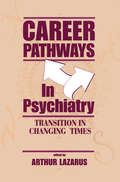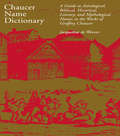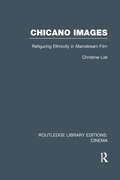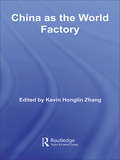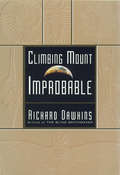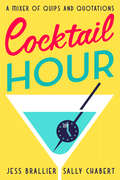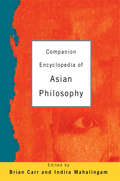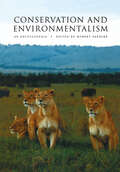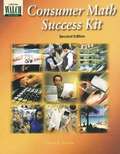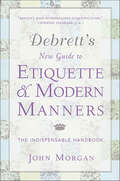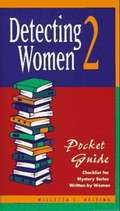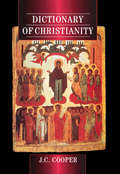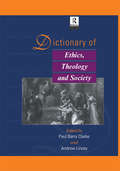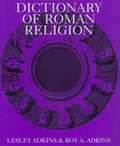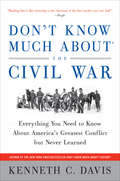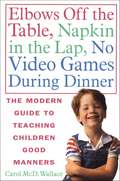- Table View
- List View
Basic Black
by Karen Grigsby Bates Karen E. HudsonEtiquette for real people who live real lives. In Basic Black, Karen Grigsby Bates and Karen Elyse Hudson have gathered those elements that are, well, just basic to making life more livable-and they've added something specific to modern life. The information in Basic Black goes from "CP Time" to "Don't You Dare," from addressing your wedding invitations to addressing a police officer who has perhaps arbitrarily stopped you as you're driving through the city. It covers traditional etiquette, such as table settings, being a good host, letter writing, and tipping. Basic Black covers the essentials of black American tradition: joining a church, mentoring young people, planning a funeral, family reunions, participating in clubs and organizations. In addition, some delicate areas seldom discussed in other etiquette books are addressed here, such as race in the workplace, handling service people who are less than enthusiastic about having black customers, and keeping your job and your temper when racial slurs are used in your presence.As Bates and Hudson like to note, etiquette is about more than just which fork goes where: "As far as we're concerned, no one will die if you use the wrong fork, but we'll each lose a little piece of ourselves if we choose to live our lives without genuine respect for morality, character, kindness and other people."From the Trade Paperback edition.
Beyond Ritalin:Facts About Medication and Strategies for Helping Children,
by Robyn Freedman SpizmanIn Beyond Ritalin the team that wrote Is Your Child Hyperactive? takes a close look at what medication can and cannot do for those with ADHD, and explains in full detail the behavioral and other strategies that have been developed in the past 15 years to successfully cope with this complex and confusing disorder.
Bite-Size Einstein: Quotations on Just About Everything from the Greatest Mind of the Twentieth Century
by Albert EinsteinThe kindly, white-heaired old fellow with the bushy mustache once called "the world's grandfather," Albert Einstein was easily the twentieth century's most remarkable and revered man of science. His leaps of imagination changed forever the way we look at the universe. He gained international celebrity by the very force of his personality, his wry sense of humor (often at the expense of himself), and his limitless humanity.The mind of Albert Einstein bulged at the seams not only with mathematics and physics but also with an insatiable curiosity about life itself. His wide-ranging observations and opinions about the nature of life and the world--not to mention the life and world of nature--are rich in insight, wit, and wisdom. His vision also us a unique opportunity to see ourselves. His thoughts are treasures in small packages; taken as a whole, they offer images and ideas of what we are and what it is possible to be.
Books to Build On: A Grade-by-Grade Resource Guide for Parents and Teachers (The Core Knowledge Series)
by John Holdren E. D. Hirsch Jr.The hugely successful Core Knowledge Series has told the parents of first- through sixth-graders what they need to know. Now this essential companion volume helps those parents finds the books and other resources that will allow their children to learn even more about their favorite subjects.
Breakthroughs in Writing and Language (Breakthroughs Series)
by Joan Maruskin-Mott<P>"Contemporary's Breakthroughs in Writing and Language is designed to help students develop a firm basis in writing and language skills. Both the process of writing and conventions of English are covered. In particular, there are three features to note: <P>- The ""Journal Writing"" feature provides students with a variety of ideas for writing in their journals. Its main purpose is to help students start to feel comfortable as writers. In this section only, grammar and spelling are not emphasized. <P>- ""Putting Your Skills to Work,"" a highly structured writing activity, appears following language skills exercises. The writing focuses on the grammar point that was just taught. This feature helps students to understand grammar in the context of their own writing. <P>- Somewhat less structured than ""Putting Your Skills to Work,"" ""Your Turn to Write"" gives students a choice of topics and some suggestions about how to approach the topic. ""Your Turn to Write"" is followed by a checklist of a few of the major grammar and usage points in the chapter. The checklist guides students in editing their own writing."
CGI Manual of Style
by Robert McdanielAnyone can put a site up on the Web-but what makes people come back again and again? This indispensable reference is your guide to CGI (Common Gateway Interface), the key to tailoring your site to suit your visitors' needs by controlling and analyzing the flow of information on your site. No experience with C or Perl is assumed. Real-world examples are presented in easy-to follow tutorials.
California Judge Reviews (California Courts & Judges)
by Mark Thompson Elizabeth SmithCalifornia Courts & Judges has been renamed California Judge Reviews, and the guide's contents have been streamlined and restructured to emphasize attorney comments about California judges. California Judge Reviews includes candid and frank attorney comments, compiled through interviews conducted by authors Elizabeth Smith and Mark Thompson, for several hundred superior court and district court judges and commissioners. This publication includes more than 2,500 detailed biographies of state and federal judges in California. It provides biographical information on many state and some federal judges in California and attorneys' comments about most L.A. and S.F. civil judges. The book also includes a comprehensive, statewide court directory and information about associations and ADR organizations. Preparation is the key to winning, and that preparation includes knowing your judge. Be completely ready for your next court appearance with the latest 2-volume California Courts & Judges' detailed biographies, which include information such as: Pre-bench background Political affiliation Appointment dates Appointing official Association membership Education Legal authorship Age Business address Personal interests Judicial philosophy Availability as arbitrator
Canada from Afar: The Daily Telegraph Book of Canadian Obituaries
by Conrad Black David Twiston-DaviesCanada From Afar is the fruit of the remarkable flowering of obituary writing in the London Daily Telegraph during the past ten years. These lively portraits of Canadians are informed, witty, sometimes quirky, occasionally iconoclastic.They include royal courtiers, politicians, businessmen, soldiers, sailors, airmen, scientists, explorers, novelists, artists, and even journalists. Among the prominent Canadians viewed from afar are persons such as Margaret Laurence, Joey Smallwood, K.C. Irving, Raymond Burr and A.J. Casson.
Career Pathways in Psychiatry: Transition in Changing Times
by Arthur LazarusCareer transitions in psychiatry have rarely been discussed openly. Yet, in the light of health care reform and other forces affecting clinical practice, it is more important than ever that psychiatrists have information about the career options within their specialty. Career Pathways in Psychiatry: Transition in Changing Times serves that purpose. It explores the professional development and career choices of prominent American psychiatrists, each of whom is identified with a particular career track and many of whom have themselves experienced one or more career transitions. The autobiographical accounts of the contributors survey a wide range of career pathways in psychiatry, including clinical practice, HMO practice, research, administration, entrepreneurism, psychoanalysis, organized medicine, the pharmaceutical industry, public psychiatry, occupational psychiatry, forensic psychiatry, and military psychiatry. These accounts are as engaging as they are informative; their anecdotal nature and conversational tone make for pleasurable reading. References at the end of each chapter serve as recommended reading for those who wish to learn more about specific career options. Intended for psychiatric residents and psychiatrists early in their careers, Career Pathways in Psychiatry will also appeal to their more experienced colleagues, including seasoned clinicians who have contemplated career changes. With a preface summarizing research on career transitions in medicine and numerous chapters shedding light on factors contributing to resistance to change, this book will also be of interest to social scientists, mental health administrators, and professional recruiters.
Chaucer Name Dictionary: A Guide to Astrological, Biblical, Historical, Literary, and Mythological Names in the Works of Geoffrey Chaucer (Garland Reference Library Of The Humanities #Vol. 709)
by Jacqueline de WeeverPraised by reviewers as highly recommended, indispensable, and thorough, comprehensive, usable, and unquestionably useful, theChaucer Name Dictionary is the ultimate A-Z guide to the writer who stands at the head of the English curriculum. It provides full information on all the hundreds of proper names mentioned throughout Chaucer and essential to an understanding of his works. Each entry provides historical and/or literary definition, references to occurrences in Chaucer's works with explanations of the context, a list of related words, etymology, and a bibliography of primary and secondary works. Special Features The only reference source that identifies the hundreds of historical, literary, and mythological names mentioned in Chaucer, Provides reliable background information essential to understanding Chaucer's text, Alphabetical arrangement and clear format allow quick answers to reference questions, Includes an important Glossary of Astronomical and Astrological Terms, along with six astrological maps Suitable for courses in:Chaucer, Medieval English Poetry, Medieval Literature in Translation, Old and Middle English Literature, Glossary Also includes maps.
Chicano Images: Refiguring Ethnicity in Mainstream Film (Routledge Library Editions: Cinema)
by Christine ListProviding textual analysis of 12 feature films written and directed by filmmakers who explore aspects of the Chicano cultural movement, this book discusses films including Cheech and Chong's Still Smokin' (1983), El Norte (1985), and Break of Dawn (1988). The text analyzes the portrayal of Chicano, or Mexican American, identity in films by chicanos. Part historiography, part film analysis, part ethnography, this book offers a compelling story of how Chicanos challenge, subvert and create their own popular portrayals of Chicanismo. Historical stereotypical images in Hollywood films are discussed alongside contemporary images portrayed by Hollywood studios and independent Chicano filmmakers. The author examines the way in which newer films "construct new representations of Chicano culture" and present a greater variety of images of Chicanos for mainstream audiences. Originally published in 1996, this authoritative volume provides a full history of the Chicano cultural movement beginning in the 1960s as well as information on the development of Mexican American film production.
China as the World Factory (Routledge Studies in the Growth Economies of Asia)
by Kevin Honglin ZhangFew countries have integrated into the world economy as fast – or as dramatically – as China has since 1978. The world’s most populous country is emerging as a world workshop and export machine: a visit to a department store in any country will unearth a plethora of goods manufactured in the People’s Republic. China is now the world’s fourth largest exporting nation. In this important book, Kevin Zhang brings together an international team of contributors to analyze this development process. Taking a thematic approach, the book covers: * manufacturing exports and the world workshop* foreign capital and china’s industrial development* challenges from the WTO and openness. This topical analysis will be an excellent resource for postgraduate students and researchers in the fields of Asian and Chinese studies, export studies, and economics.
Climbing Mount Improbable
by Richard Dawkins Lalla WardA brilliant book celebrating improbability as the engine that drives life, by the acclaimed author of The Selfish Gene and The Blind Watchmaker. The human eye is so complex and works so precisely that surely, one might believe, its current shape and function must be the product of design. How could such an intricate object have come about by chance? Tackling this subject--in writing that the New York Times called "a masterpiece"--Richard Dawkins builds a carefully reasoned and lovingly illustrated argument for evolutionary adaptation as the mechanism for life on earth. The metaphor of Mount Improbable represents the combination of perfection and improbability that is epitomized in the seemingly "designed" complexity of living things. Dawkins skillfully guides the reader on a breathtaking journey through the mountain's passes and up its many peaks to demonstrate that following the improbable path to perfection takes time. Evocative illustrations accompany Dawkins's eloquent descriptions of extraordinary adaptations such as the teeming populations of figs, the intricate silken world of spiders, and the evolution of wings on the bodies of flightless animals. And through it all runs the thread of DNA, the molecule of life, responsible for its own destiny on an unending pilgrimage through time. Climbing Mount Improbable is a book of great impact and skill, written by the most prominent Darwinian of our age.
Cocktail Hour: A Mixer of Quips and Quotations
by Jess Brallier Sally ChabertA collection of quotes on drinking from more than one hundred of the greatest thinkers (or drinkers) in history, sure to entertain, inspire, or enlighten. US President Herbert Hoover called the cocktail hour &“the pause between the errors and trials of the day and the hopes of the night.&” It&’s a period for relaxation, reflection, and, of course, socializing. Some of our greatest minds have observed the cocktail hour, enjoying a good, stiff drink and the stimulation, amusement, and insight it can offer. In Cocktail Hour: A Mixer of Quips and Quotations, Jess Brallier and Sally Chabert mix together quotations from more than one hundred luminaries. Sip the wit and wisdom instilled in these pages from the likes of Tallulah Bankhead, Winston S. Churchill, F. Scott Fitzgerald, Fran Lebowitz, Dorothy Parker, George Bernard Shaw, Tom Waits, Tennessee Williams, and Gore Vidal. With this book, you&’ll find the ultimate literary accompaniment for those who enjoy a proper drink, a charming companion, and delightful banter. Bottoms up!
Companion Encyclopedia of Asian Philosophy (Routledge Companion Encyclopaedias Ser.)
by Brian Carr Indira MahalingamThe Companion Encyclopedia of Asian Philosophy is a unique one-volume reference work which makes a broad range of richly varied philosophical, ethical and theological traditions accessible to a wide audience.The Companion is divided into six sections covering the main traditions within Asian thought: Persian; Indian; Buddhist; Chinese; Japanese; and Islamic philosophy. Each section contains a collection of chapters which provide comprehensive coverage of the origins of the tradition, its approaches to, for example, logic and languages, and to questions of morals and society. The chapters also contain useful histories of the lives of the key influential thinkers, as well as a thorough analysis of the current trends.
Conservation and Environmentalism: An Encyclopedia
by Robert PaehlkeFocusing on both problems and solutions, this authoritative reference work maintains a healthy balance between science and the social sciences in its coverage of all aspects of the environment. The book is arranged alphabetically and is divided into three major sections: Ecology, Pollution, and Sustainability. The list of 240 contributors reads like a who's who of the world's leading conservation and environmental professionals.Best Reference Source Outstanding Reference Source
Consumer Math Success Kit, Second Edition
by David E. NewtonThe book helps students understand the terminology of consumer mathematics. Interest rates, prices, tax tables, and new nutrition information have been incorporated into the new edition.
Debrett's New Guide to Etiquette & Modern Manners: The Indispensable Handbook
by John MorganThe refinement of the past meets the pragmatism of the present in this sparkling portrayal of modern etiquette.In an era where traditional norms are often sidelined, Debrett's New Guide to Etiquette and Modern Manners emerges as a beacon of hope, tactfully intertwining the timeless elegance of decorum with a modern twist to fit the intricacies of the twenty-first century.From the simplicity of basic table manners to the sophisticated protocols required at high-profile diplomatic gatherings, the expertly curated advice is both practical and easy to implement.Celebrating the charm, allure, and perpetual importance of traditional courtesy, this guide is more than a manual; it's an ode to the civility of a bygone era and a definitive guide on carrying forth its spirit into the contemporary world.
Detecting Women 2: Pocket Guide Checklist for Mystery Series Written by Women
by Willetta L. HeisingIf you love the Fantastic Fiction website, you'll love Detecting Women 2. It's a small book of lists of series of women detectives with the authors and the books in the series. More than 600 series detectives created by women. Over 3400 mystery titles in correct series order.
Dictionary of Christianity
by J. C. CooperFirst Published in 1996. Routledge is an imprint of Taylor & Francis, an informa company.
Dictionary of Ethics, Theology and Society
by Andrew Linzey Paul A. ClarkeThis Dictionary provides a unique and groundbreaking survey of both the historical and contemporary interrelations between ethics, theology and society. In over 250 separately-authored entries, a selection of the world's leading scholars from many disciplines and many denominations present their own views on a wide range of topics.Arranged alphabetically, entries cover all aspects of philosophy, theology, ethics, economics, politics and government. Each entry includes:* a concise definition of the term* a description of the principal ideas behind it* analysis of its history, development and contemporary relevance* a detailed bibliography giving the major sources in the fieldThe entire field is prefaced by an editorial introduction outlining its scope and diversity.Selected entries include:Animal Rights * Capital Punishment * Communism * Domestic Violence * Ethics * Evil * Government * Homophobia * Humanism * Liberation Theology * Politics * Pornography * Racism * Sexism * Society * Vivisection * Women's Ordination
Dictionary of Roman Religion
by Lesley Adkins Roy A. AdkinsBreaking with the long tradition of presenting classical Roman mythology as a reworked and diluted version of its Greek counterpart, offers entries ranging from short definitions to short essays on both the primitive, native aspects and the cosmopolitan fertility of mythology incorporated from Judaism, Druidism, Mithraism, and other cultures. Includes deities and their kin, festivals, events, writers, places and buildings, cult objects, burial rites, and other aspects. Well cross-referenced, and most entries are referenced to the bibliography. Includes a glossary without pronunciation. Annotation c. by Book News, Inc., Portland, Or.
Don't Know Much About the Civil War: Everything You Need to Know About America's Greatest Conflict but Never Learned (Don't Know Much About Series)
by Kenneth C. DavisWhy did Abraham Lincoln sneak into Washington for his inauguration? Was the Gettysburg Address written on the back of an envelope?Where did the Underground Railroad run? Can you answer these questions? If not, you're not alone! New York Times-bestselling author Kenneth C. Davis comes to the rescue, deftly sorting out the players, the politics, the key events -- Emancipation and Reconstruction, Shiloh and Gettysburg, Generals Grant and Lee, Harriet Beecher Stowe -- and providing little-known facts that will enthrall even learned Civil War buffs. Vivid, informative, and hugely entertaining, Don't Know Much About® the Civil War is the only book you'll ever need on "the war that never ended."
Dr. Dean Ornish's Program for Reversing Heart Disease: The Only System Scientifically Proven To Reverse Heart Disease Without Drugs Or Surgery
by Dr Dean Ornish"Whether or not you think you'll ever be concerned about your heart, this is likely to be the most useful book about health you'll read this year, maybe ever."ESQUIREIn this breakthrough book, Dr. Dean Ornish presents dramatic evidence that heart disease can be halted or even reversed simply by changing your life-style. Step-by-step he will guide you through the extraordinary Opening Your Heart program that takes you beyond the purely physical side of health care to include the psychological, emotional, and spiritual aspects so vital to healing. This book represents the best modern medicine has to offer. It can inspire you to open your heart to a longer, better, happier life.
Elbows Off the Table, Napkin in the Lap, No Video Games During Dinner: The Modern Guide to Teaching Children Good Manners
by Carol McD. WallaceOnce upon a time girls stopped wearing dresses to school and put on jeans and tie-dyed T-shirts. It was the Age of Aquarius, when old rules of behavior no longer seemed to apply. But now that the flower children have children of their own, they're starting to wonder what the new rules ought to be.Manners expert Carol McD. Wallace, who has two sons of her own, comes to the rescue with a clear, contemporary guide to what today's parents should teach their children, when to teach it, and how to do so without turning their homes into boot camp. Here in Elbows Off the Table, Napkin in the Lap, No Video Games During Dinner, in the kind of knowing detail only a parent could offer, are step-by-step guides to: --Basic Training: The dawn of civilized behavior, or how to teach 3- to 5-year-olds to behave at meals, say "please" and "thank you", share, and apologize.--The Age of Reason: Refining the manners of 6- to 9-year-olds at home and abroad.--The Young Sophisticate: How to bring the manners of 10- to 12-year olds to high polish. --Manners for Parents: Everything from when it's okay to bring your child into work to privacy--your own and your children's.
